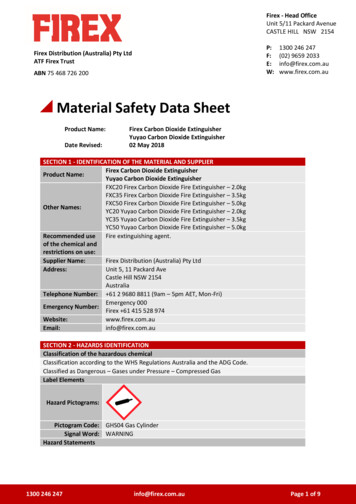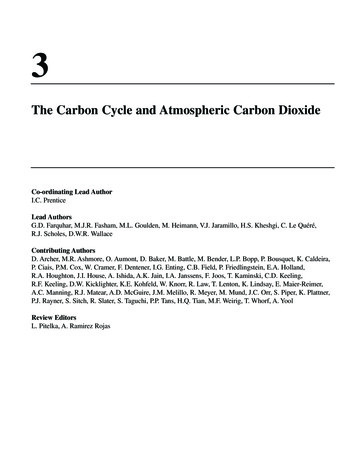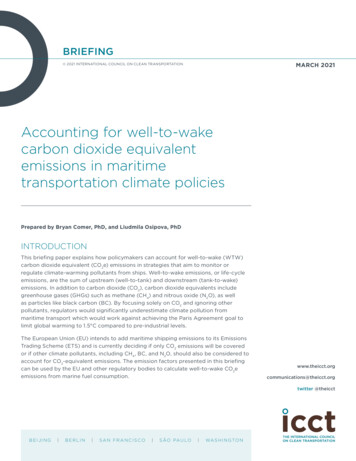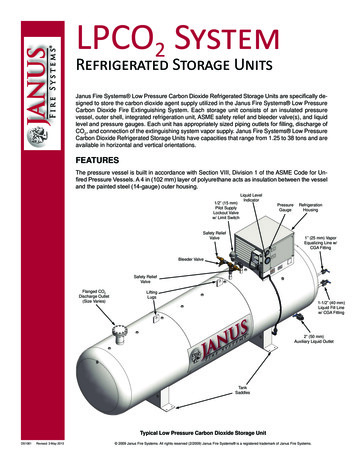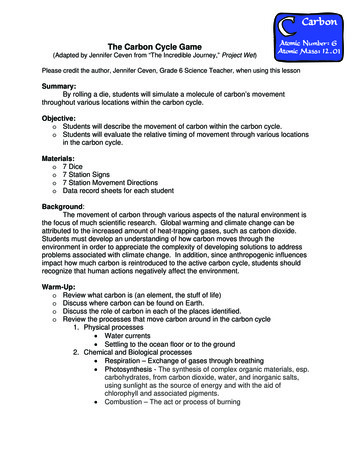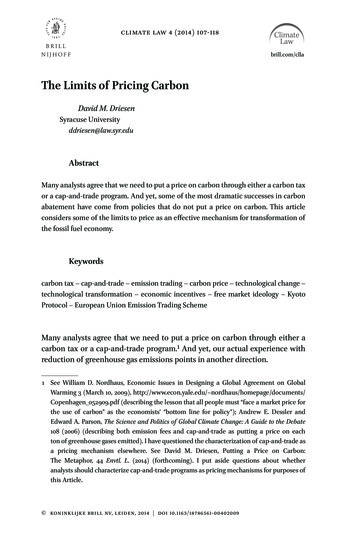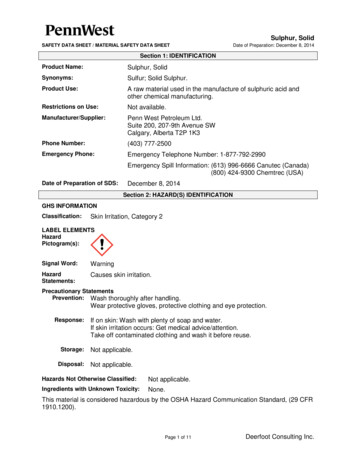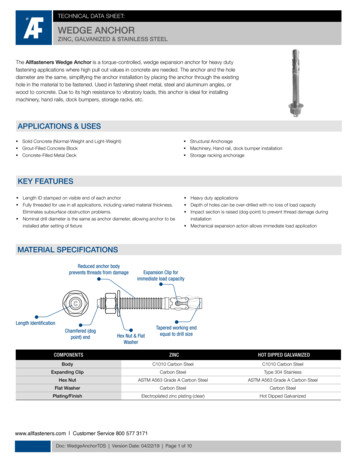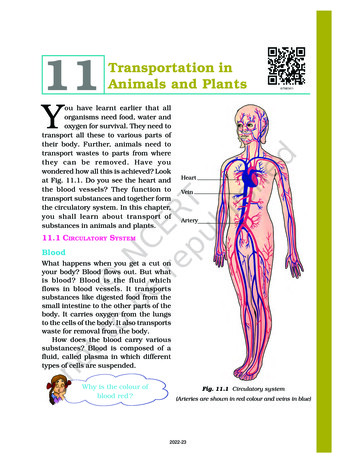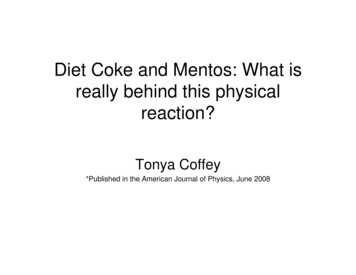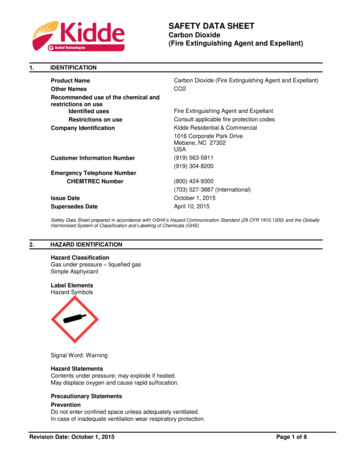
Transcription
SAFETY DATA SHEETCarbon Dioxide(Fire Extinguishing Agent and Expellant)1.IDENTIFICATIONProduct NameOther NamesRecommended use of the chemical andrestrictions on useIdentified usesRestrictions on useCompany IdentificationCustomer Information NumberEmergency Telephone NumberCHEMTREC NumberIssue DateSupersedes DateCarbon Dioxide (Fire Extinguishing Agent and Expellant)CO2Fire Extinguishing Agent and ExpellantConsult applicable fire protection codesKidde Residential & Commercial1016 Corporate Park DriveMebane, NC 27302USA(919) 563-5911(919) 304-8200(800) 424-9300(703) 527-3887 (International)October 1, 2015April 10, 2015Safety Data Sheet prepared in accordance with OSHA’s Hazard Communication Standard (29 CFR 1910.1200) and the GloballyHarmonized System of Classification and Labelling of Chemicals (GHS)2.HAZARD IDENTIFICATIONHazard ClassificationGas under pressure – liquefied gasSimple AsphyxiantLabel ElementsHazard SymbolsSignal Word: WarningHazard StatementsContents under pressure; may explode if heated.May displace oxygen and cause rapid suffocation.Precautionary StatementsPreventionDo not enter confined space unless adequately ventilated.In case of inadequate ventilation wear respiratory protection.Revision Date: October 1, 2015Page 1 of 8
SAFETY DATA SHEETCarbon Dioxide(Fire Extinguishing Agent and Expellant)2.HAZARD IDENTIFICATIONResponseNoneStorageKeep container tightly closed.Protect from sunlight and store in well-ventilated place.DisposalNoneOther HazardsDirect contact with the cold gas or liquid can cause freezing of exposed tissues. Avoid direct inhalation ofundiluted gas. Can cause suffocation by reducing oxygen available for breathing. Breathing very highconcentrations can cause dizziness, shortness of breath, unconsciousness or asphyxiation.Specific Concentration LimitsThe values listed below represent the percentages of ingredients of unknown toxicity.Acute oral toxicity0%Acute dermal toxicity0%Acute inhalation toxicity0%Acute aquatic toxicity100%3.COMPOSITION/INFORMATION ON INGREDIENTSSynonyms: CO2This product is a substance.ComponentCarbon Dioxide4.CAS Number124-38-9Concentration 99.8%FIRST- AID MEASURESDescription of necessary first-aid measuresEyesImmediately flood the eye with plenty of water for at least 15 minutes, holding the eye open. Obtainmedical attention if soreness or redness persists.SkinGently warm affected areas. Obtain medical attention if frostbite or blistering occurs or redness persists.IngestionIngestion is not considered a potential route of exposure.InhalationRemove from exposure. If there is difficulty in breathing, give oxygen. Obtain medical attentionimmediately.Most important symptoms/effects, acute and delayedAside from the information found under Description of necessary first aid measures (above) andIndication of immediate medical attention and special treatment needed, no additional symptoms andeffects are anticipated.Revision Date: October 1, 2015Page 2 of 8
SAFETY DATA SHEETCarbon Dioxide(Fire Extinguishing Agent and Expellant)4.FIRST- AID MEASURESIndication of immediate medical attention and special treatment neededNotes to PhysiciansIn case of frostbite, place the frostbitten part in warm water. If warm water is not available or impracticalto use, wrap the affected parts gently in blankets. DO NOT USE HOT WATER.5.FIRE - FIGHTING MEASURESSuitable Extinguishing MediaCarbon Dioxide is used as an extinguishing agent and therefore is not a problem when trying to control ablaze. Use extinguishing agent appropriate to other materials involved. Keep containers andsurroundings cool with water spray as containers may rupture or burst in the heat of a fire.Specific hazards arising from the chemicalContainers may explode in heat of fire.Special Protective Actions for Fire-FightersWear full protective clothing and self-contained breathing apparatus as appropriate for specific fireconditions.6.ACCIDENTAL RELEASE MEASURESPersonal precautions, protective equipment and emergency proceduresRemove leaking cylinder to a safe place. Ventilate the area. Leaks inside confined spaces may causesuffocation as oxygen is displaced and should not be entered without a self-contained breathingapparatus.Environmental PrecautionsNone - Material is a normal atmospheric gas.Methods and materials for containment and cleaning upNone - Material evaporates.7.HANDLING AND STORAGEPrecautions for safe handlingContainers should be properly stored and secured to prevent falling or being knocked over. Do not drag,slide or roll containers. Do not drop containers or permit them to strike against each other. Never applyflame or localized heat directly to any part of the containers.Conditions for safe storageStore away from sources of heat or ignition. Storage area should be: - cool - dry - well ventilated under cover - out of direct sunlightRevision Date: October 1, 2015Page 3 of 8
SAFETY DATA SHEETCarbon Dioxide(Fire Extinguishing Agent and Expellant)8.EXPOSURE CONTROLS/PERSONAL PROTECTIONControl parametersExposure limits are listed below, if they exist.Carbon DioxideACGIH TLV: 5000 ppm (9000 mg/m3) STEL: 30,000 ppm (54,000 mg/m3)OSHA PEL: 5000 ppm (9000 mg/m3)Appropriate engineering controlsUse with adequate ventilation (natural or mechanical), especially in a confined space.Individual protection measuresRespiratory ProtectionNot normally required. In oxygen deficient atmospheres, use a self contained breathing apparatus, as anair purifying respirator will not provide protection.Skin ProtectionGlovesEye/Face ProtectionChemical goggles or safety glasses with side shields.Body ProtectionNormal work wear.9.PHYSICAL AND CHEMICAL PROPERTIESAppearancePhysical StateColorOdorOdor ThresholdpHSpecific GravityBoiling Range/Point ( C/F)Melting Point ( C/F)Flash Point (PMCC) ( C/F)Vapor PressureEvaporation Rate (BuAc 1)Solubility in WaterVapor Density (Air 1)VOC (%)Partition coefficient (noctanol/water)ViscosityAuto-ignition TemperatureDecomposition TemperatureUpper explosive limitLower explosive limitFlammability (solid, gas)Revision Date: October 1, 2015Liquefied gas under pressureColorlessOdorless to Slightly AcidicNo data availableNot applicable1.522-56.6oC/-69.8 oF-78.5oC/109.2 oF (sublimation)Not flammable838 psig @70oF and 1 atmosphereNot applicableSolubleHeavier than air.Not applicableNo data availableNot applicableNo data availableNo data availableNot explosiveNot explosiveNot flammablePage 4 of 8
SAFETY DATA SHEETCarbon Dioxide(Fire Extinguishing Agent and Expellant)10.STABILITY AND REACTIVITYReactivityContainers may rupture or explode if exposed to heat.Chemical StabilityStable under normal conditions.Possibility of hazardous reactionsHazardous polymerization will not occur.Conditions to AvoidExtremely high temperatures - contact with incompatible materialsIncompatible MaterialsPowdered metals (ex. aluminum, zinc, etc.) - strong oxidizing agents – alkalisHazardous Decomposition ProductsIn contact with moisture will generate carbonic acid.11.TOXICOLOGICAL INFORMATIONAcute ToxicitySimple asphyxiant. LCLo (inhalation in humans): 90,000ppm/ 5 minutes.Specific Target Organ Toxicity (STOT) – single exposureExposure to carbon dioxide vapor at high concentrations can cause loss of consciousness which mayprove fatal due to suffocation as it displaces oxygen. Symptoms may include light headedness,dizziness, difficulty with breathing, drowsiness, nausea, mental confusion, increased blood pressure andincreased respiratory rate.Specific Target Organ Toxicity (STOT) – repeat exposureNo data available.Serious Eye damage/IrritationDirect contact with the cold gas or liquid can cause freezing of exposed tissues.Skin Corrosion/IrritationDirect contact with the cold gas or liquid can cause freezing of exposed tissues.Respiratory or Skin SensitizationAvailable data indicates this product is not expected to cause skin or respiratory sensitization.CarcinogenicityNot considered carcinogenic by NTP, IARC, and OSHA.Germ Cell MutagenicityAvailable data indicates this product is is not expected to be mutagenic.Reproductive ToxicityAvailable data indicates this product is not expected to cause reproductive toxicity or birth defects.Revision Date: October 1, 2015Page 5 of 8
SAFETY DATA SHEETCarbon Dioxide(Fire Extinguishing Agent and Expellant)11.TOXICOLOGICAL INFORMATIONAspiration HazardNot an aspiration hazard.12.ECOLOGICAL INFORMATIONEcotoxicityLC50 (Rainbow trout) 60mg/l 96 hrMobility in soilCarbon dioxide occurs naturally in the atmosphere.Persistence/DegradabilityCarbon dioxide occurs naturally in the atmosphere.Bioaccumulative PotentialCarbon dioxide occurs naturally in the atmosphere.Other adverse effectsNo relevant studies identified.13.DISPOSAL CONSIDERATIONSDisposal MethodsDispose of container in accordance with all applicable local and national regulations. Do not cut punctureor weld on or near to the container. If spilled, contents will vaporize to the atmosphere.14.TRANSPORT INFORMATIONSafety Data Sheet information is intended to address a specific material and not various forms or states ofcontainment.Special Precautions for Shipping:Individuals must be certified as Hazardous Material Shipper for all transportation modes.Pressurized Fire Extinguishers are considered a hazardous material by the US Department ofTransportation and Transport Canada.Bulk Shipments:DOT CFR 172.101 DataUN Proper Shipping NameUN ClassUN NumberUN Packaging GroupClassification for AIRTransportation (IATA)Classification for WaterTransport IMDGRevision Date: October 1, 2015Carbon Dioxide, 2.2, UN1013Carbon Dioxide(2.2) Non-Flammable GasUN1013Not ApplicableConsult current IATA Regulations prior to shipping by air.Consult current IMDG Regulations prior to shipping by water.Page 6 of 8
SAFETY DATA SHEETCarbon Dioxide(Fire Extinguishing Agent and Expellant)14.TRANSPORT INFORMATIONFire Extinguishers:DOT CFR 172.101 DataUN Proper Shipping NameUN ClassUN NumberUN Packaging GroupClassification for AIRTransportation (IATA)Classification for WaterTransport IMDGFire extinguishers, 2.2, UN1044Fire extinguishers(2.2)UN1044Not applicableConsult current IATA Regulations prior to shipping by air.Consult current IMDG Regulations prior to shipping by water.This section is believed to be accurate at the time of preparation. It is not intended to be a completestatement or summary of the applicable laws, rules, or hazardous material regulations, and is subject tochange. Users have the responsibility to confirm compliance with all laws, rules, and hazardous materialregulations in effect at the time of shipping.15.REGULATORY INFORMATIONUnited States TSCA InventoryAll components of this product are in compliance with the inventory listing requirements of the US ToxicSubstance Control Act (TSCA) Chemical Substance Inventory.Canada DSL InventoryAll ingredients in this product have been verified for inclusion on the Domestic Substance List (DSL).SARA Title III Sect. 311/312 CategorizationPressure HazardSARA Title III Sect. 313This product does not contain any chemicals listed in Section 313 at or above de minimis concentrations.16.OTHER INFORMATIONNFPA RatingsNFPA Code for Health - 1NFPA Code for Flammability - 0NFPA Code for Reactivity - 0NFPA Code for Special Hazards – NoneHMIS RatingsHMIS Code for Health - 1HMIS Code for Flammability - 0HMIS Code for Physical Hazard - 0HMIS Code for Personal Protection - See Section 8*ChronicRevision Date: October 1, 2015Page 7 of 8
SAFETY DATA SHEETCarbon Dioxide(Fire Extinguishing Agent and Expellant)16.OTHER INFORMATIONLegendACGIH: American Conference of Governmental Industrial HygienistsCAS: Chemical Abstracts ServiceIARC: International Agency for Research on CancerLCLo: Lethal concentration lowN/A: Denotes no applicable information found or availableNTP: National Toxicology ProgramOSHA: Occupational Safety and Health AdministrationPEL: Permissible Exposure LimitSDS: Safety Data SheetSTEL: Short Term Exposure LimitTLV: Threshold Limit ValueRevision Date: October 1, 2015Replaces: April 10, 2015Changes made: Update to Section 14.Information Source and ReferencesThis SDS is prepared by Hazard Communication Specialists based on information provided by internalcompany references.Prepared By:EnviroNet LLC.The information and recommendations presented in this SDS are based on sources believed to beaccurate. Kidde Residential & Commercial assumes no liability for the accuracy or completeness of thisinformation. It is the user's responsibility to determine the suitability of the material for their particularpurposes. In particular, we make NO WARRANTY OF MERCHANTABILITY OR ANY OTHERWARRANTY, EXPRESS OR IMPLIED, with respect to such information, and we assume no liabilityresulting from its use. Users should ensure that any use or disposal of the material is in accordance withapplicable Federal, State, and local laws and regulations.Revision Date: October 1, 2015Page 8 of 8
(Fire Extinguishing Agent and Expellant) Revision Date: October 1, 2015 Page 7 of 8 14. TRANSPORT INFORMATION Fire Extinguishers: DOT CFR 172.101 Data Fire extinguishers, 2.2, UN1044 UN Proper Shipping Name Fire extinguishers UN Class (2.2) UN Number UN1044 UN Packaging Group Not applicable Classification for AIR Transportation (IATA)
